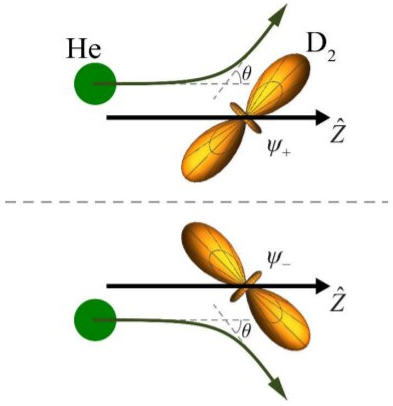博文
Science: 利用分子和原子进行双缝实验
 精选
精选
||
Science: 利用分子和原子进行双缝实验
诸平
Fig. S1 The homonuclear nature of D2 suggests symmetry of the scattering trajectories for the + and − alignment. Note how the top panel mirrors to the bottom. As a result, scattering from + at (θ, φ) is equivalent of scattering from − at (θ, –φ). Credit: DOI: 10.1126/science.abl4143
据物理学家组织网(Phys.org)2021年11月26日报道,美国斯坦福大学的一组研究人员开发了一种方法,可以在分子水平上进行著名的双缝实验(Using molecules and atoms to conduct the double-slit experiment)。相关研究结果于2021年11月18日已经在《科学》(Science)杂志网站发表——Haowen Zhou, William E. Perreault, Nandini Mukherjee, Richard N. Zare. Quantum mechanical double slit for molecular scattering. Science, 18 Nov 2021, 374 (6570): 960-964. DOI: 10.1126/science.abl4143. http://dx.doi.org/10.1126/science.abl4143.在他们发表的论文中,该小组描述了他们的技术,并建议它可以用于其他分子实验。
1801年,托马斯·杨(Thomas Young)进行了后来被称为双缝实验(double-slit experiment)。当时,他把它作为一种证明光像波一样运动的方法。从那时起,人们发现光当然也具有粒子的性质,双缝实验在不同条件下以不同的方式进行。其他研究表明,电子、原子和分子也表现出同样的行为。在这项新的研究中,研究人员仅使用分子、单个原子和激光就将实验提升到了一个新的水平。在最初的双缝实验中,光以轨迹叠加的方式通过两个缝。在这种新方法中,只有一个狭缝,但它是在一个位置的叠加。
该团队的实验包括在一个冷却到-272℃的室内制造一束氘(D2)和氦分子(He),然后他们使用一对偏振激光脉冲将氘分子(D2)推入一个特定的振动和旋转状态,其方向不同,彼此之间呈直角,这些作为实验的狭缝。该团队还强迫其他氘分子进入一种状态,在这种状态下,它们是假设裂缝的两个方向。当氦原子从重叠的分子中散射出去时(沿着相互干扰的不同路径),氘可以在某种意义上同时“感受到”它们。当氦原子与分子碰撞时,氘 (deuterium) 原子被释放回原来的状态,然后被电离,由研究小组进行研究。
研究人员认为,除了以一种新的方式进行双缝实验外,他们的工作还为以一种新的方式研究量子行为(制备新类型的物质)奠定了基础。他们的结论是,他们的技术也可以用于研究消相干(decoherence)。
上述介绍,仅供参考。欲了解更多信息,敬请注意浏览原文或者相关报道。
Double slits with molecular states
Despite decades of research, the role of quantum mechanical effects in molecular scattering has not yet been fully investigated and can still demonstrate fascinating results, even for simple triatomic systems. Zhou et al. show that the entangled bond axis orientations in the biaxial state of a deuterium molecule can act as the two slits of a double-slit interferometer for rotationally inelastic collision with a helium atom, giving rise to quantum interference between two indistinguishable pathways (see the Perspective by Wang and Yang). The present work presents an elegant example of quantum interference in molecular scattering that is conceptually similar to the famous Young’s optical double-slit experiment. The proposed molecular interferometer could be used to coherently control the phases in various molecular processes in future experiments. —YS
Interference observed in a double-slit experiment most conclusively demonstrates the wave properties of particles. We construct a quantum mechanical double-slit interferometer by rovibrationally exciting molecular deuterium (D2) in a biaxial (v = 2, j = 2) state using Stark-induced adiabatic Raman passage, where v and j represent the vibrational and rotational quantum numbers, respectively. In D2 (v = 2, j = 2) → D2 (v = 2, j′ = 0) rotational relaxation via a cold collision with ground state helium, the two coherently coupled bond axis orientations in the biaxial state act as two slits that generate two indistinguishable quantum mechanical pathways connecting initial and final states of the colliding system. The interference disappears when we decouple the two orientations of the bond axis by separately constructing the uniaxial states of D2, unequivocally establishing the double-slit action of the biaxial state. This double slit opens new possibilities in the coherent control of molecular collisions.
https://blog.sciencenet.cn/blog-212210-1314259.html
上一篇:双魔幻的发现
下一篇:Nature: 中德美科学家用富勒烯制造不那么脆的金刚石
